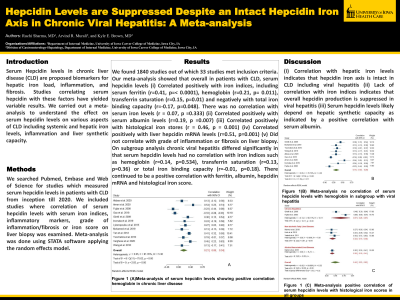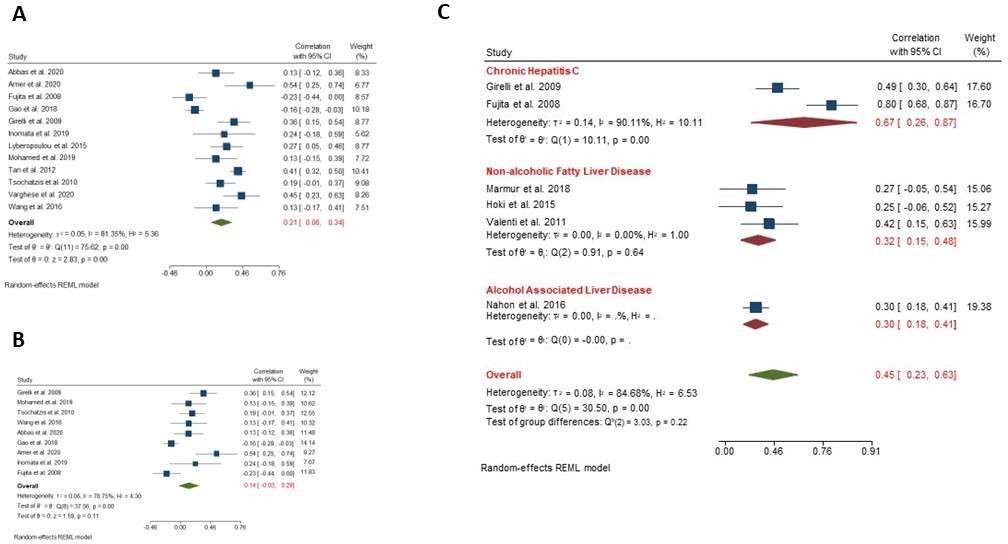Back


Poster Session B - Monday Morning
Category: Liver
B0514 - Hepcidin Levels Are Suppressed Despite an Intact Hepcidin Iron Axis in Chronic Viral Hepatitis: A Meta-Analysis
Monday, October 24, 2022
10:00 AM – 12:00 PM ET
Location: Crown Ballroom

Has Audio

Ruchi Sharma, MD
University of Iowa Hospital and Carver College of Medicine
Coralville, IA
Presenting Author(s)
Ruchi Sharma, MBBS, MS, MRCS1, Arvind R. Murali, MD2, Kyle E. Brown, MD3
1University of Iowa Hospital and Carver College of Medicine, Coralville, IA; 2Orlando Health, Orlando, FL; 3University of Iowa Hospitals and Clinics, Iowa City, IA
Introduction: Serum Hepcidin levels in chronic liver disease (CLD) are proposed biomarkers for hepatic iron load, inflammation, and fibrosis. Studies correlating serum hepcidin with these factors have yielded variable results. We carried out a meta-analysis to understand the effect on serum hepcidin levels on various aspects of CLD including systemic and hepatic iron levels, inflammation and liver synthetic capacity.
Methods: We searched Pubmed, Embase and Web of Science for studies which measured serum hepcidin levels in patients with CLD from inception till 2020. We included studies where correlation of serum hepcidin levels with serum iron indices, inflammatory markers, grade of inflammation/fibrosis or iron score on liver biopsy was examined. Meta-analysis was done using STATA software applying the random effects model.
Results: We found 1840 studies out of which 33 studies met inclusion criteria. Our meta-analysis showed that overall in patients with CLD, serum hepcidin levels (i) Correlated positively with iron indices, including serum ferritin (r=0.41, p=< 0.0001), hemoglobin (r=0.21, p= 0.011), transferrin saturation (r=0.15, p=0.01) and negatively with total iron binding capacity (r=-0.17, p=0.048). There was no correlation with serum iron levels (r = 0.07, p =0.333) (ii) Correlated positively with serum albumin levels (r=0.19, p =0.007) (iii) Correlated positively with histological iron stores (r = 0.46, p = 0.001) (iv) Correlated positively with liver hepcidin mRNA levels (r=0.51, p=0.001) (v) Did not correlate with grade of inflammation or fibrosis on liver biopsy. On subgroup analysis chronic viral hepatitis differed significantly in that serum hepcidin levels had no correlation with iron indices such as hemoglobin (r=0.14, p=0.534), transferrin saturation (r=0.13, p=0.36) or total iron binding capacity (r=-0.01, p=0.18). There continued to be a positive correlation with ferritin, albumin, hepcidin mRNA and histological iron score.
Discussion: (i) Correlation with hepatic iron levels indicates that hepcidin iron axis is intact in CLD including viral hepatitis (ii) Lack of correlation with iron indices indicates that overall hepcidin production is suppressed in viral hepatitis (iii) Serum hepcidin levels likely depend on hepatic synthetic capacity as indicated by a positive correlation with serum albumin.

Disclosures:
Ruchi Sharma, MBBS, MS, MRCS1, Arvind R. Murali, MD2, Kyle E. Brown, MD3. B0514 - Hepcidin Levels Are Suppressed Despite an Intact Hepcidin Iron Axis in Chronic Viral Hepatitis: A Meta-Analysis, ACG 2022 Annual Scientific Meeting Abstracts. Charlotte, NC: American College of Gastroenterology.
1University of Iowa Hospital and Carver College of Medicine, Coralville, IA; 2Orlando Health, Orlando, FL; 3University of Iowa Hospitals and Clinics, Iowa City, IA
Introduction: Serum Hepcidin levels in chronic liver disease (CLD) are proposed biomarkers for hepatic iron load, inflammation, and fibrosis. Studies correlating serum hepcidin with these factors have yielded variable results. We carried out a meta-analysis to understand the effect on serum hepcidin levels on various aspects of CLD including systemic and hepatic iron levels, inflammation and liver synthetic capacity.
Methods: We searched Pubmed, Embase and Web of Science for studies which measured serum hepcidin levels in patients with CLD from inception till 2020. We included studies where correlation of serum hepcidin levels with serum iron indices, inflammatory markers, grade of inflammation/fibrosis or iron score on liver biopsy was examined. Meta-analysis was done using STATA software applying the random effects model.
Results: We found 1840 studies out of which 33 studies met inclusion criteria. Our meta-analysis showed that overall in patients with CLD, serum hepcidin levels (i) Correlated positively with iron indices, including serum ferritin (r=0.41, p=< 0.0001), hemoglobin (r=0.21, p= 0.011), transferrin saturation (r=0.15, p=0.01) and negatively with total iron binding capacity (r=-0.17, p=0.048). There was no correlation with serum iron levels (r = 0.07, p =0.333) (ii) Correlated positively with serum albumin levels (r=0.19, p =0.007) (iii) Correlated positively with histological iron stores (r = 0.46, p = 0.001) (iv) Correlated positively with liver hepcidin mRNA levels (r=0.51, p=0.001) (v) Did not correlate with grade of inflammation or fibrosis on liver biopsy. On subgroup analysis chronic viral hepatitis differed significantly in that serum hepcidin levels had no correlation with iron indices such as hemoglobin (r=0.14, p=0.534), transferrin saturation (r=0.13, p=0.36) or total iron binding capacity (r=-0.01, p=0.18). There continued to be a positive correlation with ferritin, albumin, hepcidin mRNA and histological iron score.
Discussion: (i) Correlation with hepatic iron levels indicates that hepcidin iron axis is intact in CLD including viral hepatitis (ii) Lack of correlation with iron indices indicates that overall hepcidin production is suppressed in viral hepatitis (iii) Serum hepcidin levels likely depend on hepatic synthetic capacity as indicated by a positive correlation with serum albumin.

Figure: Meta-analysis of correlations serum hepcidin levels (A) positive correlation with hemoglobin in chronic liver disease (B) no correlation with hemoglobin in subgroup with chronic viral hepatitis (C) overall positive correlation with histological iron scores
Disclosures:
Ruchi Sharma indicated no relevant financial relationships.
Arvind Murali indicated no relevant financial relationships.
Kyle Brown indicated no relevant financial relationships.
Ruchi Sharma, MBBS, MS, MRCS1, Arvind R. Murali, MD2, Kyle E. Brown, MD3. B0514 - Hepcidin Levels Are Suppressed Despite an Intact Hepcidin Iron Axis in Chronic Viral Hepatitis: A Meta-Analysis, ACG 2022 Annual Scientific Meeting Abstracts. Charlotte, NC: American College of Gastroenterology.

